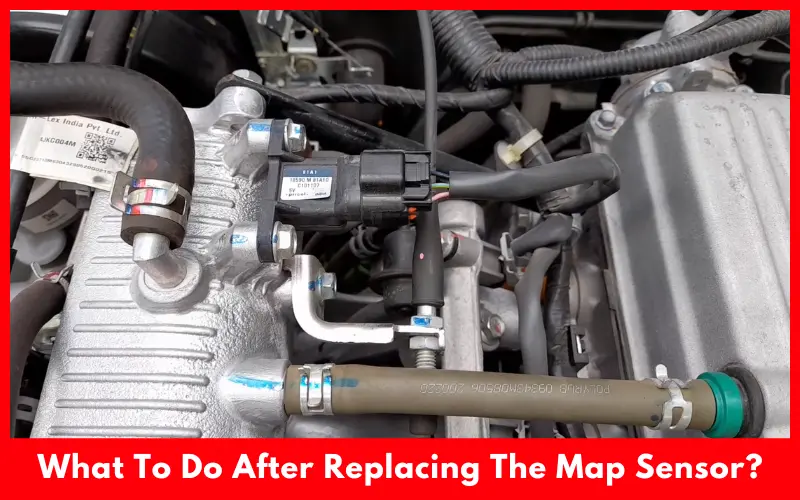MAP (Manifold Absolute Pressure) sensor is one of the vital sensors associated with cars of the modern era. It is assigned with the task of keeping track of pressure at intake manifold and its data is relevant to the ECU which is the heart of engine management and it makes necessary adjustments in the fuel delivery and ignition timing.
But what happens after replacing the MAP sensor? The MAP sensor becomes slow after continuous usage. This can lead to problems related to poor fuel economy, rough idling, and lower engine power. We will discuss the purpose of the MAP sensor, signs that may indicate its probable malfunctioning and what to do after replacing MAP sensor.
Article Summary
How Does MAP Sensor Work On A Car?
MAP sensor has to be understood before its replacement. This means learning its purpose embedded in the engine system. The essential job of this sensor is to measure the pressure inside the manifold. The pressure inside the manifold is directly proportional to the engine’s load.
ECU gathers the annotated data together with the other sensor inputs and computes a proper air-fuel ratio for the combustion process under consideration. In turn, this improves the fuel consumption and performance across the varied operating conditions. Therefore, a bad or faulty MAP sensor can result in the engine economy being thrown off the line, which is accompanied by both poor engine performance and increased emissions.
What To Do After Replacing The MAP Sensor?
After replacing the MAP (Manifold Absolute Pressure) sensor in your vehicle, it’s important to take a few steps to ensure everything is working properly:
Clear The Trouble Codes
Once you have determined that the MAP sensor failure is the reason responsible for the engine code, turn off the trouble codes in ECM using an OBD-II scanner. With these procedures, you will be able to ensure that any new problems are isolated and dealt with in time.
Test drive
Eliminate your vehicle for a couple of days and take it for a trial run. Note how it moves at different speeds, settles down, and instantly flags whenever you touch the accelerator pedal. Avoid any stalling, erratic idling or so-called hesitations. Those are the usual results of a problem deep beneath the hood.
Monitor Engine Performance
Monitor vehicle performance over the next several commutes and look for any deviations from its usual behavior. In making sure those issues will not come back, do not wait to replace your standard engine management unit (ECU) by getting MAP sensors.

Check For Leaks
Be sure that there is no vacuum leak or space openings in the intake system. If there is leakage that can affect the MAP sensor readings and thereby affecting the performance of the engine.
Verify Sensor installation
Verify that the MAP sensor had been installed accordingly and quite close. Verify that all electric connections are properly secured and loose wires have been properly dealt with.
Consider A Reset
Sometimes, a logical approach to this problem can be making the computer of the vehicle (ECM reset) and instructing it that it needs to get used to the new sensor through the use of the Throttle Body relearn procedure in order to optimize its operation.
Consult A Professional if Needed
If you still face the same problems with your vehicle’s performance though you have just replaced the MAP sensor, that may be the symptom of a hidden issue. However, in most such occasions, a qualified mechanic/automotive expert would be the right person to suspect and address the recovery of your vehicle.
Take care of these steps; you will be able to be sure that replacing your vehicle MAP sensor is successful, and your automobile runs without any problem.
Signs Of MAP Sensor Failure
It is key to specify the symptoms present when a faulty MAP sensor occurs. It helps to perform crucial maintenance and to handle repairs on time. Common indicators of MAP sensor issues include:Common indicators of MAP sensor issues include:
Decreased Fuel Efficiency
Non-functioning MAP sensor will most likely cause the engine to misfire which will be rich or lean respectively, and will consequently result in reduced fuel economy.
Rough idling Or Stalling
Changes in manifold pressure that can produce rough idling or instantaneous stalling of the car as it is stopped have remained the pressing issue.
Reduced Engine Power
The ECU continuously attempts correct inaccurate gauge signals, and the engine definitely reduce power while accelerating.
Check Engine Light (CEL) illumination
In most cases, the code of a detrimental MAP sensor may be stored conveniently in the ECU or the computer and the CEL light is thus turned on.

How To Replace The MAP Sensor?
The depleted friction is the initial symptom of MAP sensor replacement, which is necessary to get back the best engine performance. Here’s a step-by-step guide to navigating the replacement process:
Diagnostic Assessment
Start with the definitive confirmation of the source of the problem by means of a comprehensive diagnostic examination. With an OBDII scanner, you can look up on the puzzle codes and check if the MAP sensor is indeed the cause of all the problems.
Locate The Sensor
The MAP (manifold absolute pressure) sensor is normally located on or near the air intake, is connected to a hose and an electrical connector, designed to sense the absolute pressure in the manifold. Look at the service brochure for your vehicle or do an online search below where this is precisely.
Disconnect The Electrical Connector
Meticulously, separate the electrical connector attached to the MAP sensor without compromising its structural integrity.
Remove The Sensor
According to the mounting method, usage of proper tools should preliminary be focused on for dismantling and removing the old MAP sensor from the housing casing. Note the flaw of any types of root patches and seals that you may have to replace.
Install The New Sensor
After removing the old sensor, gently install the new MAP sensor yet securely into its place which can be finger-tight. Replace any gaskets or seals if necessary and determine the vacuum leaks. Create your Own Post! Writing Prompt We live in a society that prioritizes productivity and efficiency above all else.
Reconnect The Electrical Connector
Apply the electrical connector to the new MAP sensor by letting it engage to its intended position and a fixed connection.
Test And Verify
Before agreeing to replace it, take the approaching vehicle for a test drive to make sure how it feels after the installation. Tune fault code or CEL and make sure rough idling is normal.
Clear Trouble Codes
In case of it, apply the over the top monitor on vehicles ECU which will clear up any storage fault codes to test the ECU progression.
FAQs on What To Do After Replacing The Map Sensor?
How Do I Locate The MAP Sensor in My Vehicle?
The MAP sensor is usually fabricated on or near the intake manifold, where it is connected to vacuum piping and electrical connection. The precise location of its installation may be different in various cars or even within the same car brand. Refer to the vehicle manufacturer’s services’ manual and online resources for recommended procedures on how to find the MAP sensor.
Can I Replace The MAP Sensor Myself, Or Should I Seek Professional Assistance?
Nevertheless, changing the MAP sensor is quite an essential and easy task for mechanical enthusiasts. It is very much important that the correct diagnosis and installation have been done, for avoiding any of the future inventory. It is important that you look for an expert mechanic or automotive technician to help you with this.
Do I Need To Reset The ECU After Replacing The MAP Sensor?
In certain situations where ECU (Engine Control Unit) is reset after installing the new MAP sensor the vehicle will work in performance and optimization mode. This process of clearing can be done with an OBD-II scanner which will eliminate any trouble codes stored in it. However, it is necessary to follow guidelines developed by the manufacturer and to execute relearn operations if required to ensure the proper operation of the vehicle.
Conclusion
In the complex system of automotive engineering each part code will be indispensable in ensuring the stable and the smooth operation of the entire system. While the TPS sensor supplies information about how much fuel is delivered to the engine, and O2 sensor with regard to the level of oxygen within it, MAP acts as a hinge between pressure, and fuel delivery, by collecting and transmitting their data.
Through the identifying and issuing of replacement steps of damaged MAP sensors, the cars owners can maintain excellent performance and lengthen the time of service on these engines with no problem. Be aware that when encountering any problems with the engine, the MAP sensor may be one cause of them. Thus, going on a journey of reviving your vehicle’s performance through energy intake is an important step.

